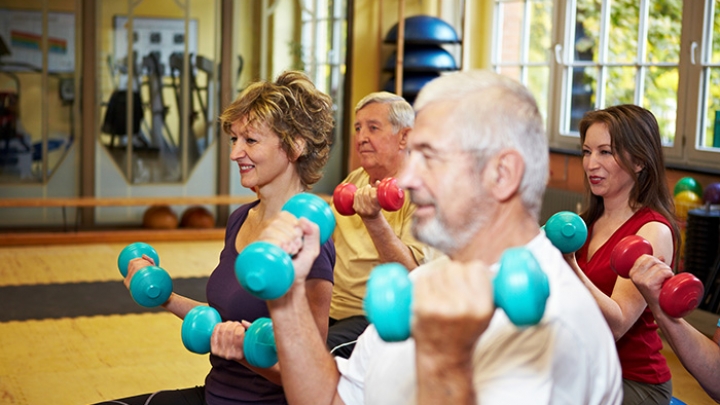If chronic obstructive pulmonary disease (COPD) leaves you feeling tired and breathless, exercising may be the last thing you want to do. But you should do it to help your symptoms.
Exercise does not directly improve lung function. But by conditioning your muscles it helps build your endurance level. This improves how well your body uses oxygen. That means you won’t have to use as much energy to breathe, and you’ll be able to do more before you start feeling tired.
Pulmonary rehab
Many people with COPD benefit from exercise training that is part of a pulmonary rehabilitation program.
- Such programs are often available through a hospital on an outpatient basis.
- They usually meet three times a week for eight weeks.
- The exercise portion of most programs focuses on endurance exercises to build leg strength, such as walking and stationary cycling.
- Some programs also include resistance exercises, using elastic bands or very light weights, to build leg strength.
Improved leg strength helps make it easier to perform typical daily activities like preparing meals, housekeeping, and grooming, which can help you maintain your independence. Improving leg strength may also reduce your risk of falling. Building upper arm strength with resistance training also makes daily activities easier.
Many doctors recommend pulmonary rehabilitation for people with moderate to severe COPD. Pulmonary rehabilitation benefits patients in all stages of COPD1. And evidence from several studies has shown that participants in pulmonary rehabilitation programs improved significantly compared with those who did not use these programs. Additionally, old age shouldn’t be a deterrent to pulmonary rehab, according to one study2, which found that people who were frail responded well to rehabilitation.
To find a rehab program near you, ask your doctor for a referral. Or contact the American Lung Association (800-LUNGUSA; website) or the American Association of Cardiovascular and Pulmonary Rehabilitation (312-321-5146; website).
Exercising on your own

Many people with COPD don’t have a pulmonary rehab program nearby or don’t have insurance coverage for such a program. These people should still exercise on their own. Studies have found that people report having less trouble breathing when performing daily activities even with home-based rehab3.
If you are not used to exercising, it’s important to begin walking slowly at a comfortable pace for a short period (try starting with five to 10 minutes daily) three to five days a week. Do not increase your walking time until you are able to walk the entire time without stopping.
When you can walk without stopping, increase your walking time by one to two minutes each week. Aim for a goal of walking 30 minutes without stopping. This amount of time might sound like a stretch, but many people with severe lung disease are able to reach this goal over time.
Try not to let bad weather keep you from your walking routine. You can always walk around your local mall if you are unable to exercise outdoors.
Beyond walking

There are many daily physical activities that provide your body with exercise. These include:
- Gardening
- Golfing
- Shopping
If you like ballroom dancing, swimming, yoga, or Pilates, ask your doctor if these activities are good options for you. It helps to choose activities you enjoy; that way you’ll be more likely to stick with them.
The key to performing these activities safely is to pace your breathing in coordination with the activity.
- You can learn more about paced breathing through pulmonary rehabilitation or a COPD support group.
- Ask your doctor for a referral or check with the American Lung Association or the American Association of Cardiovascular and Pulmonary Rehabilitation.
Before you start or stop your exercise program
Before you start an exercise program, remember these two important things:
- If you haven’t previously exercised, check with your doctor before starting to be sure it’s okay. Your doctor can also tell you what types of exercises are best and how much you should do.
- If your doctor prescribed oxygen for regular use, make sure to use it when you exercise. Oxygen will help relieve breathlessness, making it easier for you to exercise.
Don’t forget that if you stop exercising regularly, all your progress will be lost. If you are currently exercising as part of a pulmonary rehab program, you’ll need to continue your exercise routine after the program ends.
- Ask if your program has a plan that allows you to continue exercising with others with COPD.
- The program staff can also design a program for you to continue at home.
If you’ve been a home-based exerciser from the start, be sure to occasionally add some new exercises so you don’t get bored with the same old routine. If you need motivation, try exercising with a friend. You’ll likely end up motivating each other.
Tips for exercising with COPD
Stop exercising if you feel any of these symptoms:
- Dizziness or weakness
- Heart palpitations
- Shortness of breath
- Any pain
If you are in a great deal of pain or discomfort, call your doctor.
Keep the following helpful tips in mind:
- Don’t exercise outside on high-ozone days or on days that are too cold, hot, or humid. Extreme temperatures can make breathing difficult.
- If your medications change, ask your doctor whether the change will affect your ability to exercise.
- If your exercise regimen has been interrupted for a few days, reduce your activity level when you start up again and then build up to your regular schedule.
References:
- Global Initiative for Chronic Obstructive Lung Disease (GOLD) 2015
- Matthew Maddocks. Thorax, June, 2016.
- François Maltais. Annals of Internal Medicine, December, 2008.

